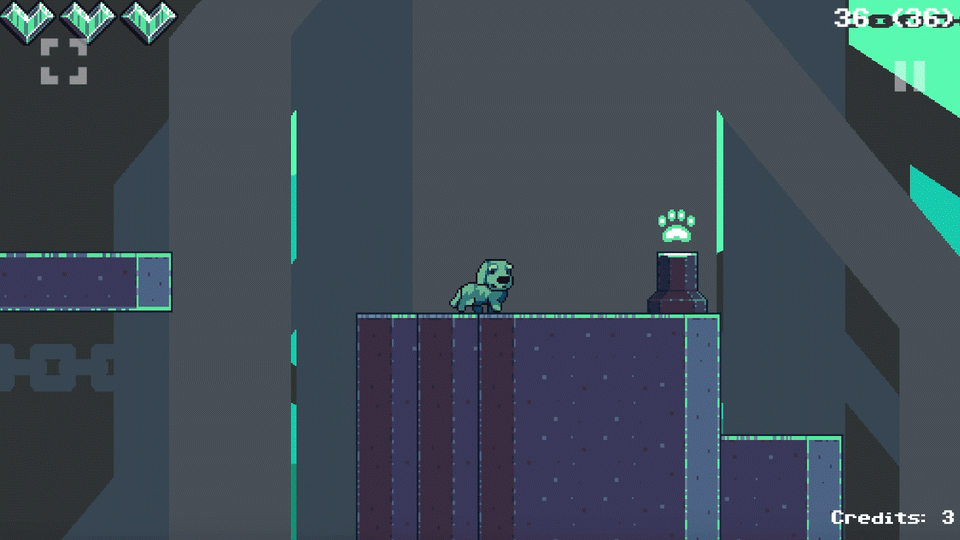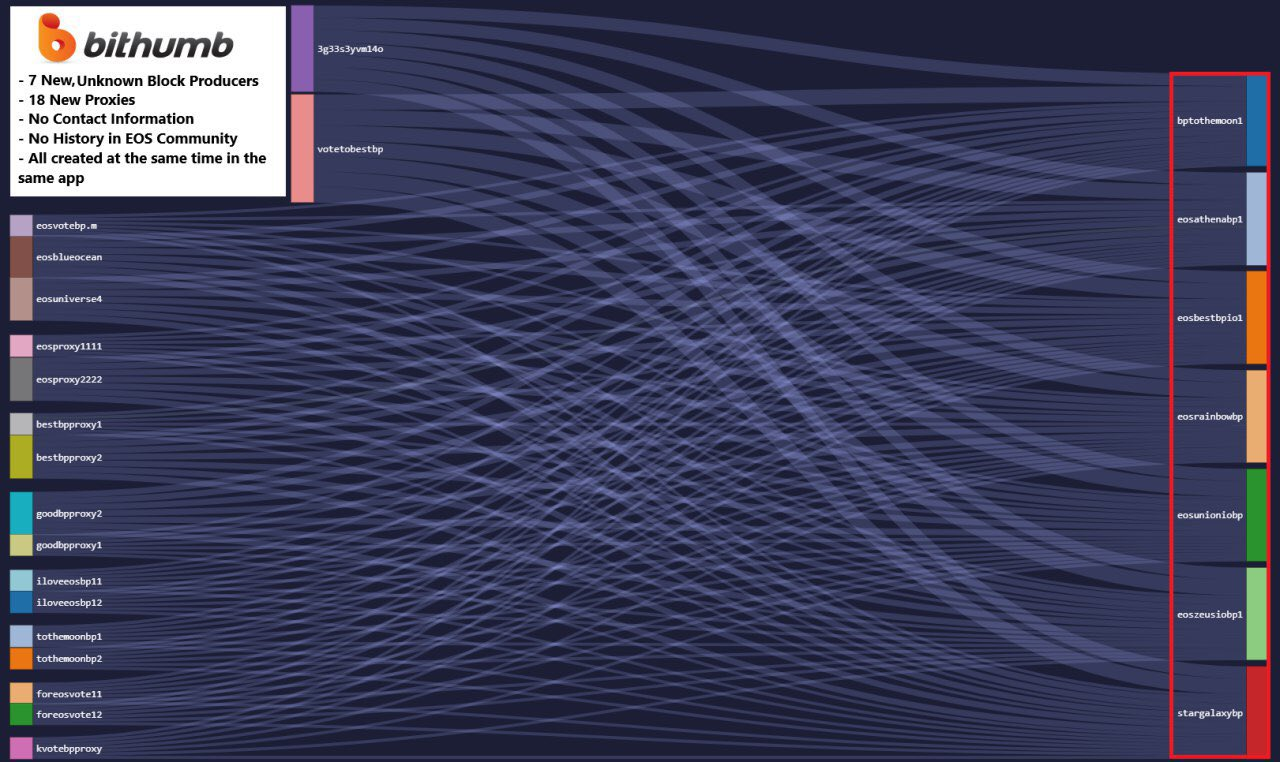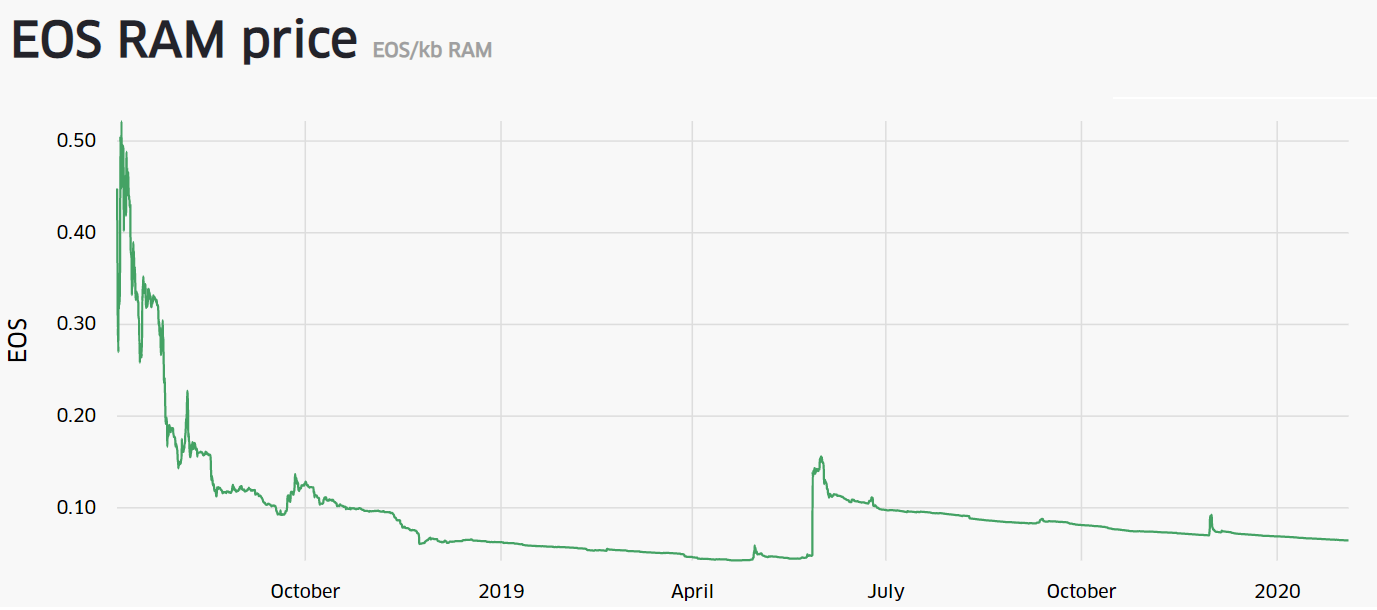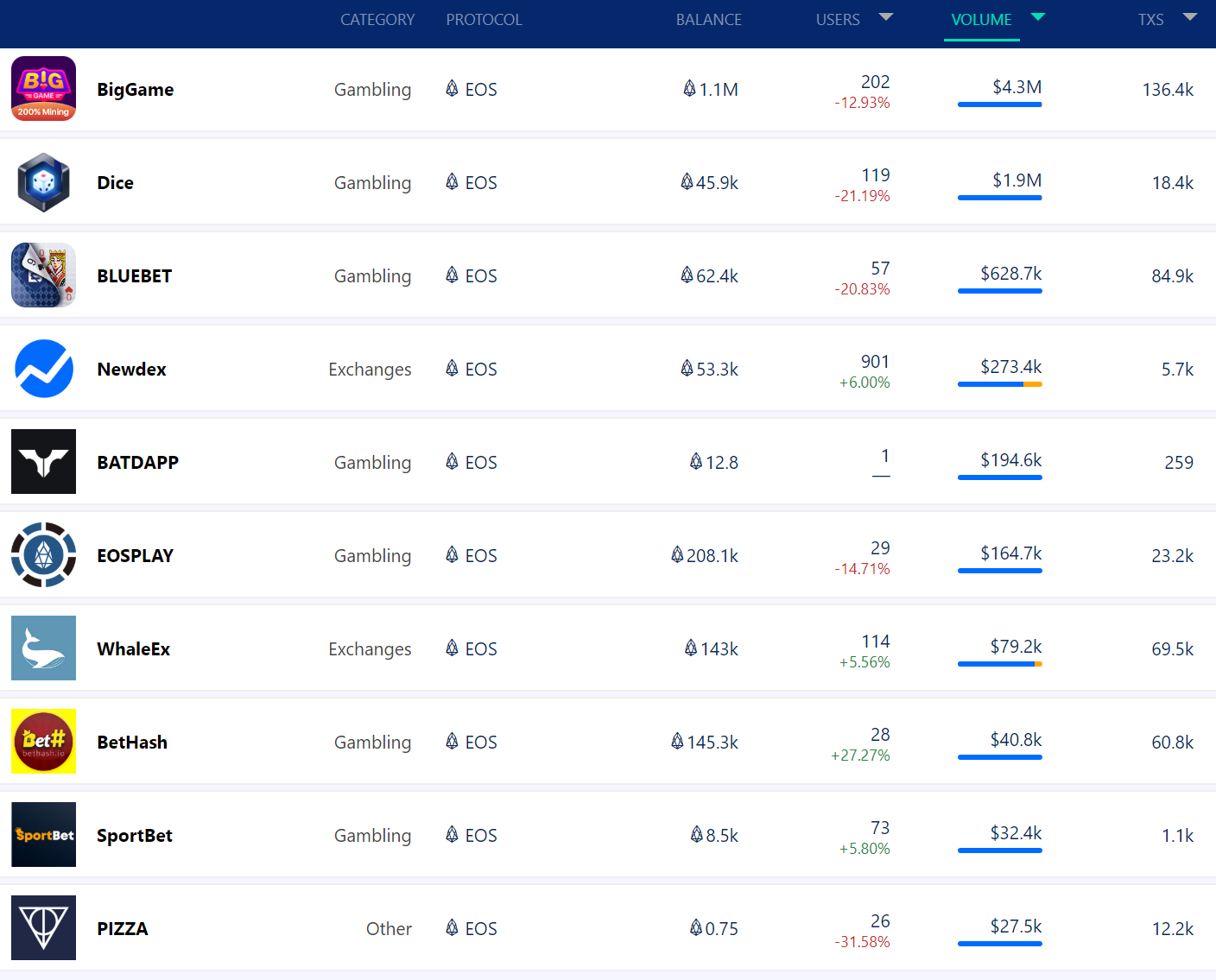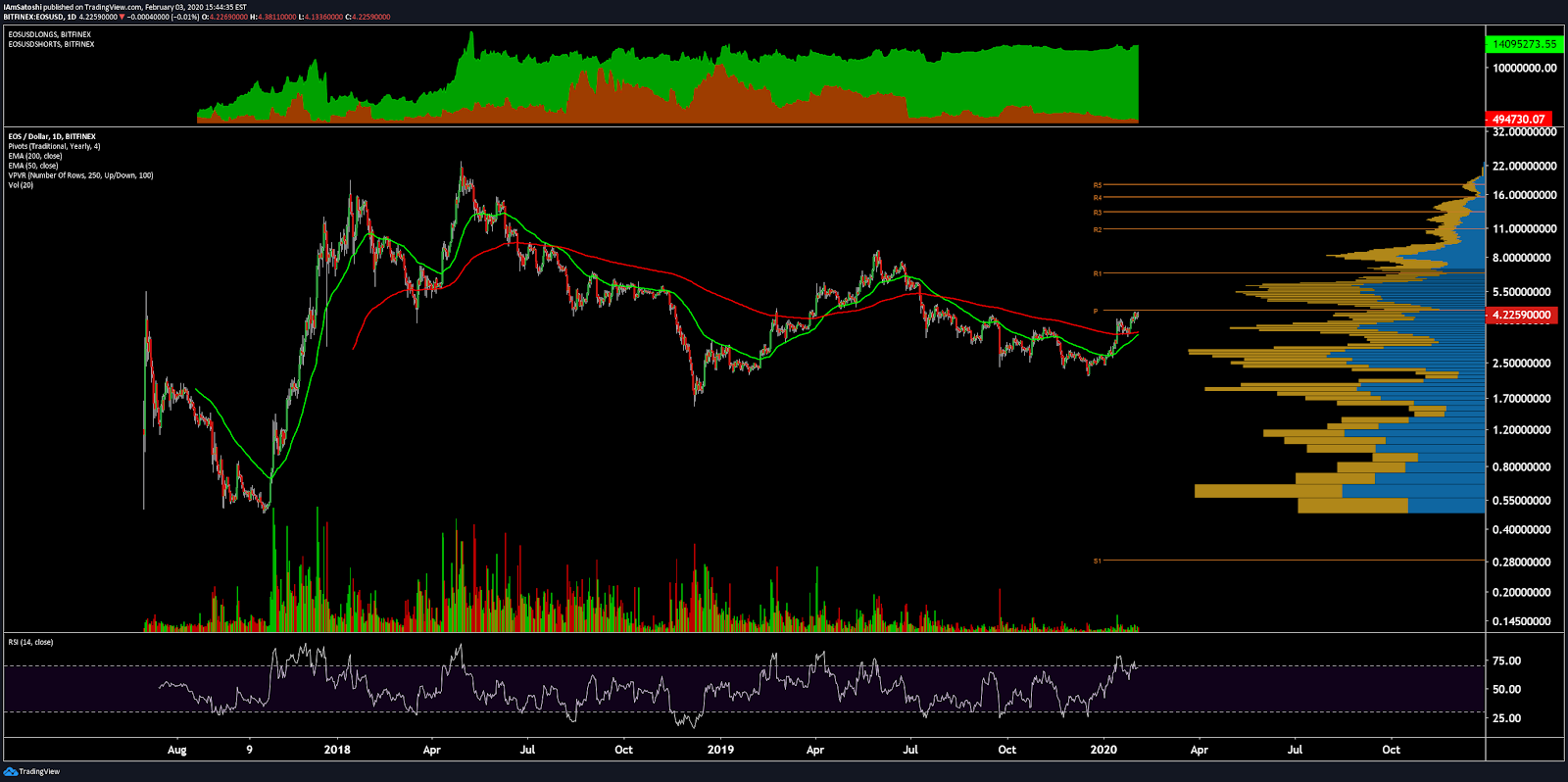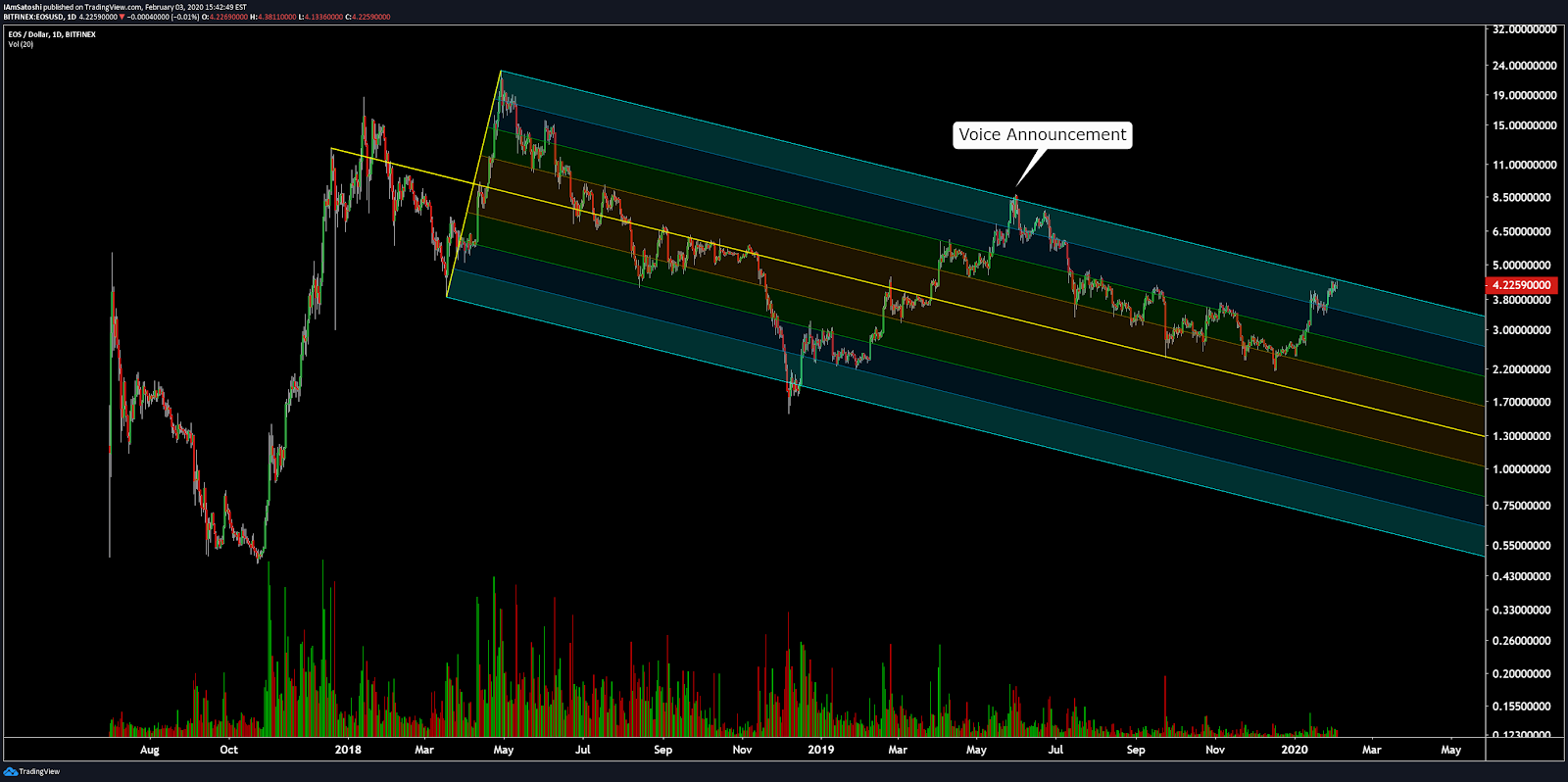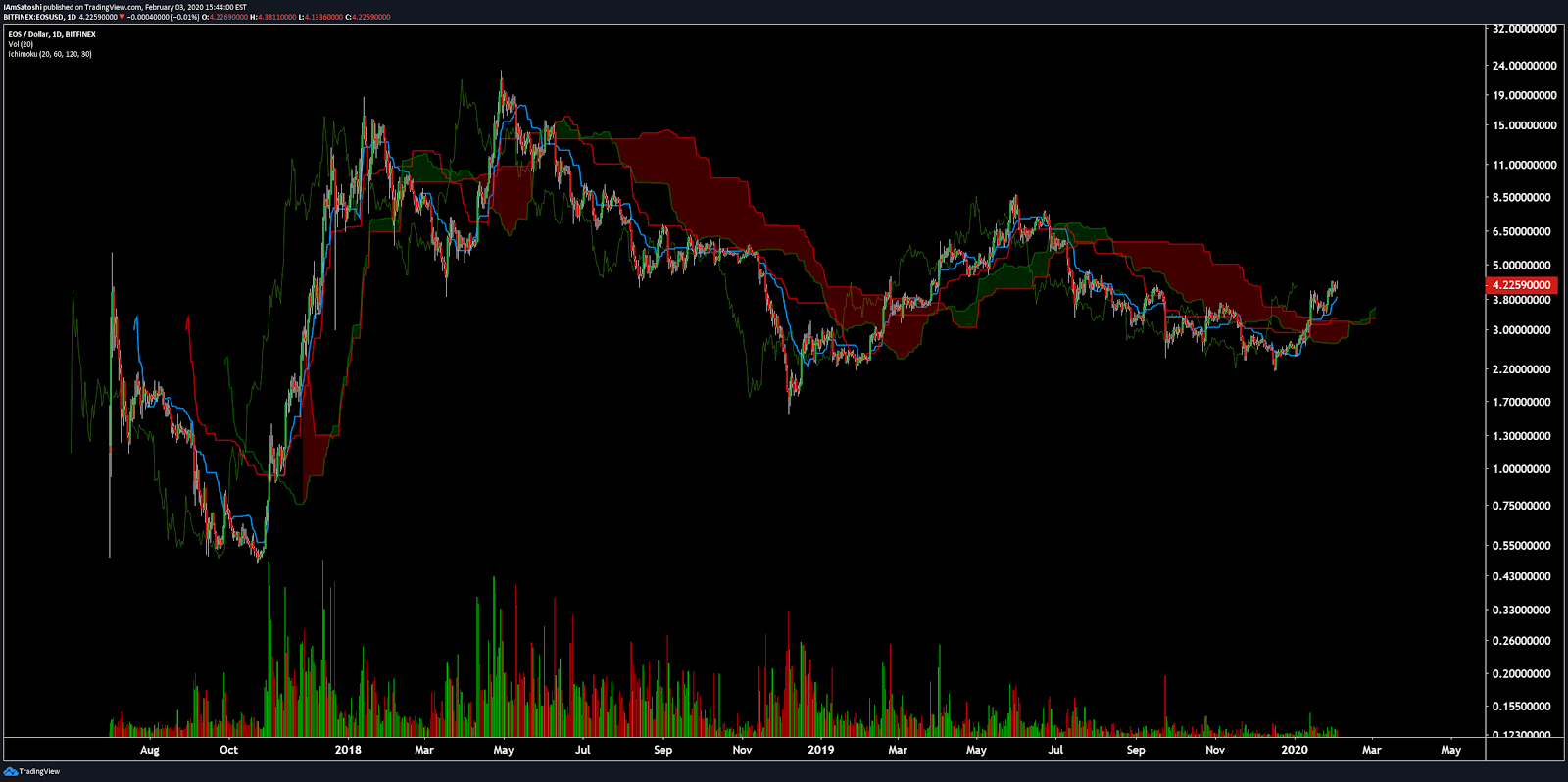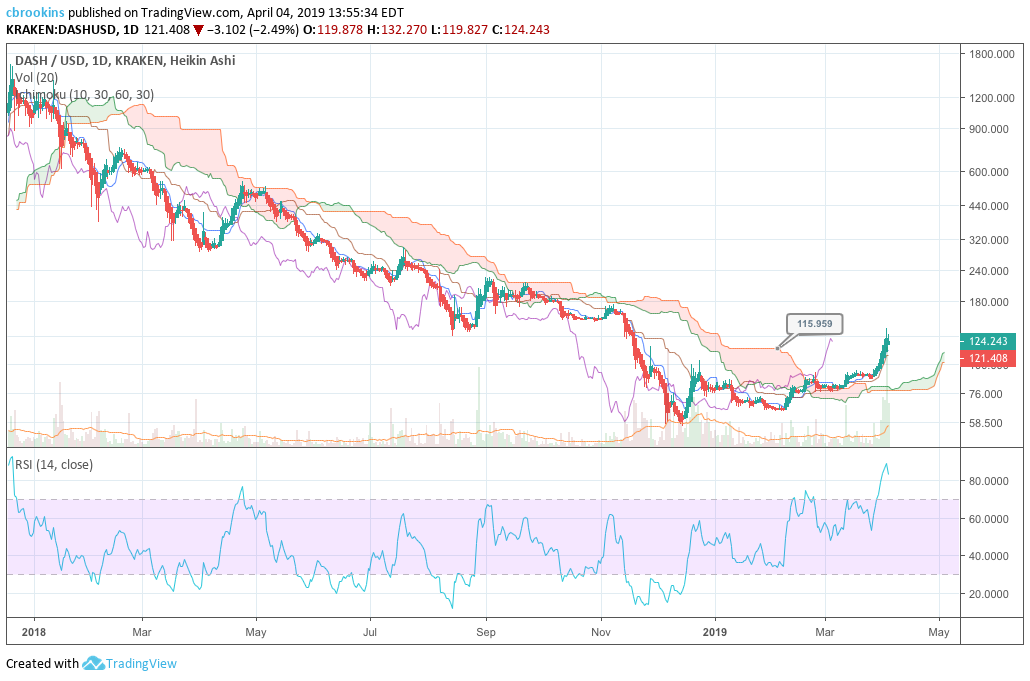Omisego Price Analysis: Key releases in 2019
The OMG token has enjoyed a period of positive price activity in 2019 and the Omisego network appears to be evolving. Concerns regarding utility remain, however, and short term onchain fundamental indicators lean bearish.
OmiseGO (OMG), is an Ethereum based decentralized banking and exchange solution that utilizes Plasma sidechain technology. It gained market notoriety as one of the original ICO unicorns, achieving a $1 billion network valuation (market cap) as an ERC-20 token, without offering a real product or token utility.
It’s just over two years since the OMG public token sale ICO (June 25, 2017) raised ~USD 25,000,000 in funding. The token is still yet to provide tangible on-chain utility for holders. However, recent developments of the OmiseGO project show that some progress is being made. The project suffered heavily during the bear market facing negative sentiment and challenging external markets, losing its USD 1 billion+ valuation. OMG’s current market cap is ~326 million USD and the token’s global spot price is ~USD 3.23.
In 2019 the price of OMG has risen a handsome 79%, however, the price remains well below its all-time high of just over USD 23 achieved in the early 2018 altcoin bull market. External market conditions (mostly the Bitcoin rally) have helped drive this year’s gains, however, over the last 6 months OmiseGO has achieved several milestones. The project has released two testnets, a viable gaming Dapp that interacts with the testnets, and recently, a centralized exchange solution (Go.exchange) that includes incentives to encourage increased usage of the OMG token.
OmiseGO aims to use the decentralized, permissionless, scalable, secure nature of the blockchain to provide a public good and solve a real-world problem, financial empowerment in South-East Asia.
There are millions of unbanked individuals in the region, and because of infrastructure issues and the challenges involved in obtaining identification documents, the likelihood of this group being able to participate in the global financial system in the near term is slim. This is the problem that OmiseGO’s accessible, permissionless payment option is attempting to solve.
Family relationships in the SEA region are often interconnected across regions and dispersed throughout multiple countries. An individual in Malaysia might also have family in Singapore, Hong Kong or India. Individuals often face very high exchange/bank fees on transactions such as remittance payments because the coordination between cross-border financial entities is slow and inefficient.
OmiseGO is an entity under Omise Holdings, which also includes Omise Payments and GO.Exchange. Omise Payments is an online payment gateway offering a wide range of processing solutions (for example, integrating local merchants into WeChat payment systems). The service is quite popular with tangible adoption in Thailand and Japan. GO.Exchange is a centralized crypto exchange with a unique transaction fee and token burn model. It was released in September 2018.
In October 2018, Global Brain, Japan’s largest private venture capital firm, made an undisclosed investment in the Omise group. The investment decision was based on the Omise ecosystem’s potential position as a facilitator of global, cross-border transactions. The deal is structured to leverage the platform’s blockchain based payment integration services and its ability to connect the unbanked to its decentralized finance solutions. The Omise ecosystem’s ability to attract a visible, prominent partner within the Asian VC space is likely reflective of the visibility and credibility the Omise project retains in the geographic region.
The OmiseGO model and tools
The OmiseGO business model is set up as an interoperable exchange solution, bringing together digital and fiat currencies, between platforms, using the blockchain. In the future, if successful, it would compete with crypto exchanges such as Kraken and Coinbase, as well as crypto payment services like Bitpay and Wyre.
In 2019, OmiseGO released the new version of an integral e-wallet solution. The OmiseGO eWallet suite is a white-label, open-source, fully customizable eWallet to digitize and store all types of assets. The e-wallet will be essential for the OmiseGO ecosystem. Potential OmiseGO merchants can now trial their own digital wallet services through a local ledger. Eventually, they’ll be able to connect to a decentralized blockchain exchange service to form a federated network on the OMG network. This will allow providers to facilitate the exchange of currencies (digital or fiat) into any other currency, leveraging the Ethereum network and Plasma.
The OmiseGO e-wallet application isn’t just a regular e-wallet. The device it is attached to will act as a node, verifying transactions on the OmiseGO blockchain (a Plasma child chain attached to the Ethereum root chain). However, it is not enough just to have a wallet open and installed, there needs to be value held in the wallet, and this is where OMG tokens and the PoS mining model comes in.
Because the e-wallet is white-label, providers can manage and integrate OmiseGO operations according to their own requirements. It is open-sourced and fully customizable, and can be changed and developed to suit multiple provider requirements. It can also be used to store company loyalty points, employee benefit points, game tokens, cryptocurrency, or even fiat.
Part of this solution is the recently launched e-wallet open source SdK (Software Developer Kit) which will allow for simple integration into the OmiseGO platform. Being open-source, the progress the OmiseGO team is making on its e-wallet solutions can be viewed and commented on.
Issues within the e-wallet UI and UX are continually being fixed and there are consistent updates to the community on this progress.
OmiseGO: Scalability within Ethereum
Managing and facilitating cross-currency transfers via the legacy financial system is a complex multi-operational solution. OmiseGO says it will be able to facilitate multiple fiat-to-fiat, fiat-to-crypto exchanges instantly, cheaply and between providers/electronic payment providers (EPPs or across border financial entities). However, any blockchain is likely to struggle with verifying these transaction loads.
OmiseGO integrates with the Ethereum based off-chain scaling solution Plasma. Through Plasma, every EPP on OmiseGO will enter a smart-contract with ETH, which will funnel a supply of liquidity onto its own, off-chain centralized network, allowing it to operate smoothly, without flooding or compromising the decentralized OmiseGO network.
In the above diagram, the OmiseGO network DEX and individual federated merchant networks are Plasma blockchains or ‘child chains’ which function on top of the root chain, Ethereum. Source: Plasma in 10 minutes.
There are two solutions to this problem. Firstly, liquidity pools for small transfers, where EPPs will hold a pool of liquidity for small transfers between their most popular destinations. Secondly, for larger transfers, an amount of ETH will be bonded via a smart contract to the OmiseGO blockchain and this will allow for a large Yen-Baht transaction to happen via a Yen-to-Ether, Ether-to-Baht route facilitated on the OmiseGO network.
There is no reason that Ethereum needs to be used, but the network’s size and robustness make it a natural choice. The OmiseGO proof-of-stake (POS) block reward model works by giving greater rewards to nodes/validators who have larger investments in the blockchain. So, having more OMG tokens means access to more fees which positively correlates with an increase in the usage and activity on the network. OmiseGO proof-of-stake holders earn rewards for confirming operations that occur on the Plasma child chains.
The greater reward stems from miners with more OMG taking more risk. If the network turns out poorly, and the tokens start losing value, the miners with higher stakes are worse off.
In the present market, the price of the OMG token is propped up by the market’s conviction in the future success of the OmiseGO blockchain (because the network is not yet live, and OMG does not yet have utility). Once the OmiseGO mainnet launches, even if an investor is not interested in being a node on the blockchain, having OMG gives them a chance to sell their stake in it, to someone who is.
There will initially be a tight quorum of 200 transaction validators on the OmiseGO child chain, however, token holders can stake their tokens to pools who validate on their behalf and allow any holder to earn confirmation rewards passively.
While the progress the network has made over the last few months will be encouraging to some community members and OMG token holders, the fact that there is no set date for the release of a publicly usable, real-world payment capable version of the OmiseGO blockchain remains a frustration.
Historically, OmiseGO has had challenges managing the expectations of its token holding community. A number of posts on blogs and on the official OmiseGO subreddit express frustration at project heads who hyped the project during the bull run, helping to drive the token’s price towards $20, and the lack of subsequent efforts to try to ensure the token was not sold off heavily in the bear market.
Strategies that have been perceived by the community as being empty marketing tactics include; OmiseGO CEO Jun Hasegawa’s overly bullish tweeting, vague pictures from official OmiseGO social accounts inside Google Headquarters (hinting at a possible partnership that did not come) and announcements about minor events such as the creation of Github repos. The project since has pulled back its overly bullish/highly speculative social media posting strategy. OmiseGO hired a new CEO in April 2019, which may suggest a move towards a more robust business practice and operations.
OmiseGO released the 2nd alpha testnet (V. 0.2) network’s Minimum Viable Plasma solution, Samrong, in late May 2019. The testnet has Plasma functions such as deposits, transfers, exits, and in-flight (transaction in progress) information. Based on internal testing it is “able to process over 1.2 MM transactions with a peak measured throughput of over 2700 transactions per second so far.”
Samrong implements new changes based on lessons learned from OmiseGO’s first testnet Ari. Samrong adds new transaction signatures using the EIP 712 standard. This allows a user to sign transactions through wallets like Metamask and a meta-data field and allows businesses/Dapps to store any arbitrary data in their transactions.
The Samrong testnet appears to have had just six transactions in the last 24 hours suggesting that it may not have yet gathered much public interest or traction.
Also integrated into the Samrong OmiseGO alpha is the platform’s first integrated Dapp, Plasma Dog. Plasma Dog is a retro, bit-based side-scroller game. The user plays ‘Officer Dog,’ a blockchain-dwelling canine who captures ‘UTXOs’ and ‘Atomic swaps’ while avoiding spikes, ‘double spends,’ and ‘invalid blocks’. ‘UTXOs’ are coins within the game that are sent to a player’s wallet in real-time. Other collected in-game rewards are reflected as blockchain transactions.
Plasma dog gameplay
Plasma Dog was developed in partnership with Hoard, a blockchain development company. There are further ambitions to integrate the OmiseGO network as a solution to transfer in-game collectibles across the Ethereum network. Hoard is working on integrating the blockchain-based collectibles within the indie game My Memory of Us, which is popular on Steam, Xbox 1, PS4, and it was recently ported to the Nintendo Switch console. When a Plasma capable version of the game is launched it is likely to be one of the most sophisticated examples of blockchain integration within a media solution.
In a recent AMA, a community manager from Hoard said factors such as cheap fees and easy fiat on-ramping are reasons why developers are excited to use the OmiseGO network.
There is no clear indication when the OmiseGO Plasma solution will be released for the Ethereum mainnet and begin real monetary transactions but the most recent roadmap from April suggests it will be in 2019.
In April, OmiseGO announced the appointment of a new CEO, Vansa Chatikavanij. With new leadership, the project may operate with new vision, priorities and business goals. In a blog written by Chatikavanji following the appointment she outlined the core goals for OmiseGO in 2019:
- To onboard more enterprise and start-up customers to test, collect feedback, and iterate towards optimizing product-market fit.
- Launching an open-source go-to-market strategy for the network and eWallet Suite.
- Strengthening OmiseGO’s overall engagement with regulatory bodies, particularly in priority Asia-Pacific countries to ensure the companies legal compliance and to be part of the conversation in policy creation.
The newest addition to the wider Omise ecosystem, the crypto exchange Go.Exchange, was soft-launched 4 months ago. It functions with a new native token, GOT, which has utility as a means to signal to the exchange a preferred token for it to burn with transaction revenue.
Users earn GOT from trading and then use it as a stake to vote on tokens they would like to burn on Go.Exchange. For example, if BTC is the token most voted for in a given voting round, GO.exchange will use earn revenues to burn an associated amount of BTC.
Beginning from June 25th, Go.Exchange will use 100% of transaction revenues to burn OMG tokens. Users of the exchange with over 500 OMG will receive a 50% discount cash back on trading fees.
On-chain data for the OMG ERC20 address indicates that there has been a pick up in transaction volume, transaction count and unique address activity in the lead up to the June 25th date. This suggests that the Go.Exchange promotion may have had the intended effect of driving new transaction activity for the OMG token.
The Go.Exchange policy of burning external tokens as a user reward, and affecting their supply schedules, is unusual and potentially disruptive. How the market in the medium/long term reacts to the recently released Go.Exchange product is unclear but some crypto analysts have raised concerns surrounding this exchange revenue model.
Objective on-chain fundamentals
NVT signal
Derived from the NVT ratio, the NVT signal is a responsive blockchain valuation metric developed by Willy Woo and Dmitry Kalichkin.
Crypto markets are prone to bubbles of speculative purchasing that don’t reflect underlying network fundamentals. The NVT signal provides insight into what stage of this price cycle a token may be at.
A high NVT signal is indicative of a network that is going through one of these bubble periods and may move towards a position of becoming overbought/overvalued, as the market’s speculative momentum slows.
The OMG token’s on-chain volume indicators lean marginally bearish. The recent medium-term uptick in the price of the token over the last 6 months has coincided with a rising NVT signal that appears to be close to a historically indicated ‘overbought’ level. Recently OMG’s NVT signal hit 120 points, which has been a previous cycle inflection point. Hitting this point in the past has driven NVTS to drop quickly in the past.
If the NVT signal begins to drop quickly after hitting an upward limit, this is likely to drive downward pressure towards the price resulting in a short term readjustment.
On-chain volume at this stage is likely driven by users seeking to speculate. At this stage, it is not clear how profitable OmiseGO proof-of-stake mining will be when launched, or how its earnings will compare to other proof-of-stake alternatives like Tezos or DASH. If the OMG PoS launches successfully offering users stable passive income, OMG will have new store of value characteristics.
PMR
Metcalfe’s law is a measure of the connections in a network, as established by Robert Metcalfe, the founder of Ethernet. It has subsequently been used to analyze the true value of network-based financial products like Facebook and Bitcoin. By comparing it to price, it can provide a useful tool to assess whether a token is over or undervalued.
It is also a more straightforward metric to assess when compared to on-chain transaction volume, which can be challenging to measure accurately in USD terms. Addresses are measured as the number of unique sending and receiving addresses participating in transactions daily.
The PMR signal of OMG has historically been high, generally ranging between 4-7 points for most of its existence. The PMR value also has a tendency of dropping and rising quickly. This suggests that most of its value is speculative and not driven by tangible user activity and network effects, with market cap (network value) dominating against Metcalfe’s law. PMR at this stage is likely not a useful indicator for future price movements.
When the production-ready versions of the OmiseGO Plasma and DEX are released, Metcalfe’s law and network effects will likely become important considerations.
A cryptocurrency’s network effects increase when new users join and strengthen the network, making it more valuable for existing users. The most direct network effects are improved liquidity and utility. More daily active users can be indicative of a higher level of merchant and payment service adoption to utilize the OmiseGO ecosystem (more cross-asset and border transaction activity) and more counterparties willing to accept OMG for payments.
Exchanges and trading pairs
The most popular trading option for OMG is USDT (US Dollar Tether) with the pair currently handling over 67% of daily trading volumes. The second most popular market is the OMG/BTC pair. Together the top two pairs make up 87% of the daily OMG trading volume. There is some liquidity on the OMG fiat trading with the US dollar trading pair.
There was a sharp uptick in OMG trading volumes beginning around February 2019. This pickup has been driven primarily by USDT trading. This may suggest a change in the nature and demographics of buyers purchasing OMG.
The USD value of the daily volume of the entire OMG exchange trading market is ~USD 65 million.
A mix of exchanges dominates the OMG trading marketplace, with 5 different entities operating the top 5 OMG trading pairs. The OMG/USDT market on Huobi is the most active market in the ecosystem. OMG is also tradeable on high profile exchanges such as Binance and Bifinex.
Technical Analysis
Like most alts, OMG has slowly nudged North over the past few months. A potential roadmap for upcoming price movements can be found using exponential moving averages (EMAs), volume (VPVR), Pitchforks (PFs), chart patterns, and Ichimoku Cloud. Further background information on the technical analysis discussed below can be found here.
On the daily chart, an important moving average event known as the Golden Cross is likely to occur soon between the 50-day EMA and 200-day EMA. For many traders, this suggests an end to any previous bear trend and the beginning of bullish momentum. The bullish cross will end the nearly 400-day bear trend since the previous cross, known as a Death Cross. The 200-day EMA at US$2.29 should also now act as support. Volume resistance (horizontal bars) sits at US$3.00 to US$3.50 and US$6.00 to US$7.00 There are no active RSI or volume divergences currently.
The long/short open interest on Bitfinex (top panel, chart below) is currently heavily net long. Over the past month, longs have increased while shorts have remained flat. A significant price movement downwards will result in an exaggerated move further, as the long positions will continue to unwind. This is known as a “long squeeze.” However, Bitfinex long/short ratios have historically had little bearing on price action for OMG.
Turning to the Ichimoku Cloud, four metrics are used to indicate if a trend exists; the current price in relation to the Cloud, the color of the Cloud (red for bearish, green for bullish), the Tenkan (T) and Kijun (K) cross, and the Lagging Span. The best entry always occurs when most of the signals flip from bearish to bullish, or vice versa.
Cloud metrics on the three-day time frame, with doubled settings (20/60/120/30) for more accurate signals, are currently neutral; price is in the Cloud, the TK cross is bullish, and the Lagging Span is in Cloud and above price. As price moves into the Cloud, the potential to move towards the opposite edge of the Cloud increases substantially. This edge-to-edge trade will likely bring price to the US$4.72 level over the next few months.
Cloud metrics on the daily time frame, with doubled settings (20/60/120/30) for more accurate signals, are currently bullish; price is above the Cloud, the Cloud is bullish, the TK cross is bullish, and the Lagging Span is above Cloud and in price. Until April of this year, price had spent nearly 350 days below the Cloud, which is suggestive of a resounding end to the previous bear market. The current trend will continue to have a bullish bias so long as price remains above Cloud.
Lastly, on the daily OMG/BTC chart, price sits at a multi-year low with all trend indicators pointing to bearish continuation. Price is below the Cloud and both the 50-day and 200-day EMA. There are also no bullish divergences currently, which could suggest bearish exhaustion. However, mean reversion would bring price back the the 35,000 sat level. Based on historic volume (horizontal bars), there is essentially no support below the current price level. The trend is likely to remain bearish so long as price remains below the 200-day EMA and the Cloud.
Conclusion
The OMG token is popular and heavily traded on altcoin marketplaces. However, more than two years since its launch, the token is yet to have any tangible on-chain utility. The network’s Plasma solution is still only in an alpha stage, while the network’s DEX is still in the hands of developers. This means OMG is only bought for speculative reasons and expectations of future value. This suggests there is very little reason (beyond hope) for holders to resist against selling pressure, and a reversal of the current bullish market conditions may lead to quick retracements back to lower price levels. Objective fundamental signals also suggest a cycle based price correction may be incoming in the near term
However, the promise of a future OmiseGO decentralized exchange solution with the ability to seamlessly connect with electronic payment vendors and fiat only merchants – remains one of the most exciting and sticky ICO concepts in the crypto investment space. Leveraging the wider ecosystem’s strong Asian connections and the release of new interconnected products like the Go.Exchange, if market conditions remain favorable, OMG’s strong price performance in 2019 may be set to continue.
Technicals for the OMG/USD pair suggest a nascent confirmed bull trend with pending Golden Cross. Any additional upside in the near term will likely find significant resistance at the psychological level of US$3.00. Over the next six months, a move to the US$4.70 is projected based on high timeframe Cloud resistance. Technicals for the OMG/BTC pair are heavily bearish with no suggestion of reversal. Buyers will likely return when signs of capitulation emerge, such as a high volume price spike downward or after bullish divergence confirms.

Don’t miss out – Find out more today


